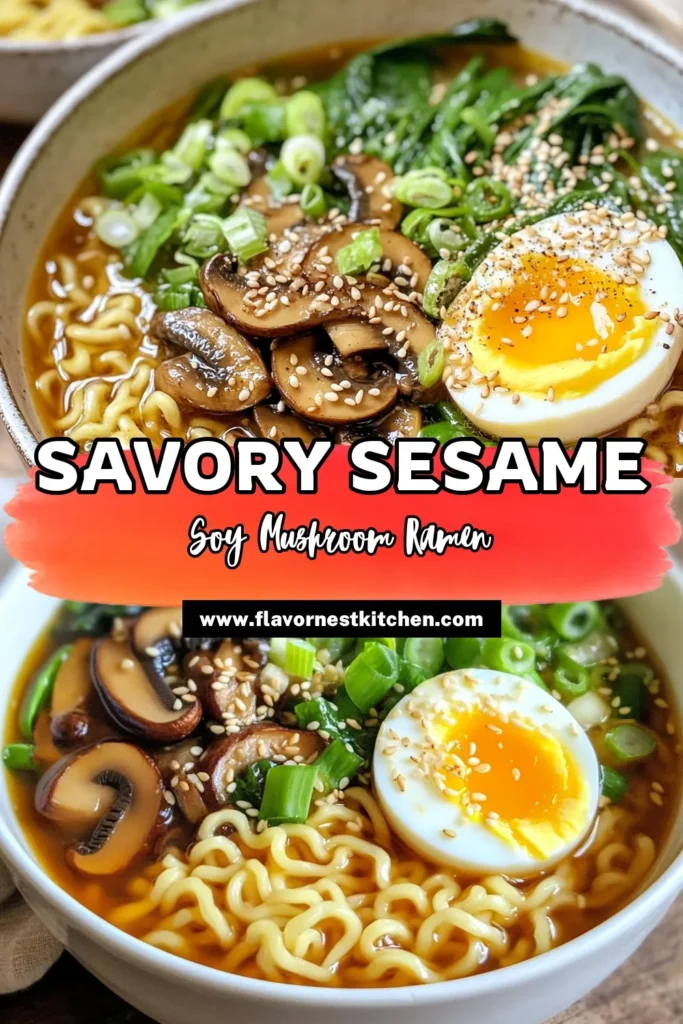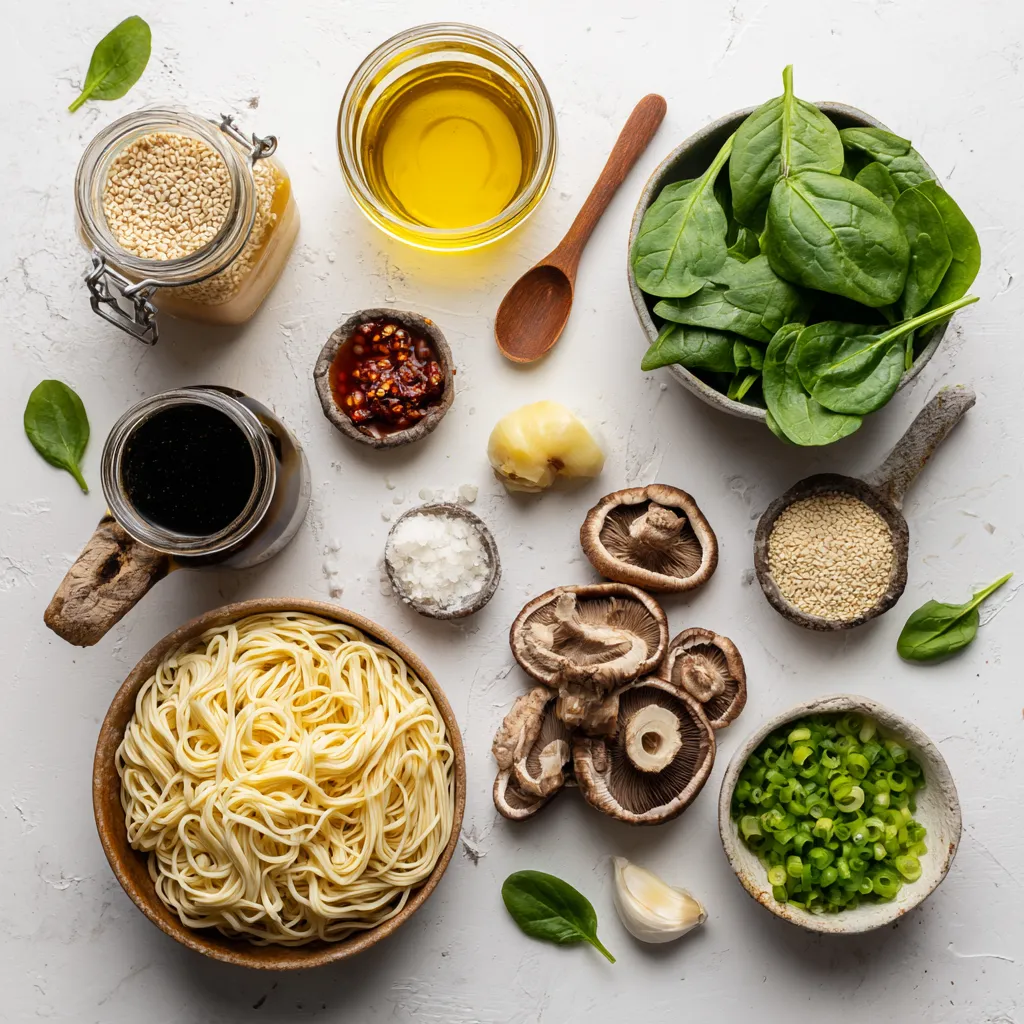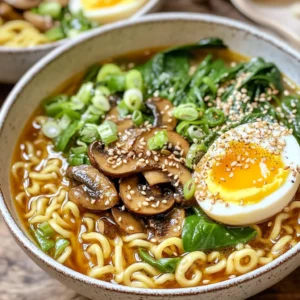WANT TO SAVE THIS RECIPE?
Are you ready to whip up a warm and cozy bowl of Sesame Soy Mushroom Ramen? This quick and tasty meal makes for the perfect weeknight dinner. With simple ingredients and step-by-step instructions, you can create a delicious broth packed with flavor and nutrition. Whether you’re a ramen newbie or a seasoned chef, this recipe will impress your taste buds and satisfy your hunger in no time! Let’s dive into the savory goodness!

Why I Love This Recipe
- Simple Ingredients: This recipe uses basic pantry staples and fresh vegetables, making it easy to whip up anytime.
- Flavorful Broth: The combination of garlic, ginger, and shiitake mushrooms creates a rich and aromatic broth that warms the soul.
- Customizable: You can easily adjust the spice level and add your favorite toppings, such as soft-boiled eggs or extra greens.
- Quick to Prepare: With a total cook time of just 25 minutes, this ramen dish is perfect for busy weeknights.
Ingredients
List of Required Ingredients
– 200g ramen noodles
– 2 cups vegetable broth
– 1 tablespoon sesame oil
– 2 cloves garlic, minced
– 1-inch piece of ginger, grated
– 200g shiitake mushrooms, sliced
– 3 tablespoons soy sauce (or tamari)
– 1 tablespoon rice vinegar
– 1 tablespoon chili paste
– 2 green onions, chopped
– 1 cup baby spinach
– 1 tablespoon sesame seeds
– Optional: Soft-boiled eggs for garnish
– Salt and pepper to taste
To make your Sesame Soy Mushroom Ramen, start with fresh ingredients. The ramen noodles are the base. Choose good quality noodles for the best texture. Next, the vegetable broth adds rich flavor. I prefer homemade, but store-bought works too.
The sesame oil gives a nutty taste. Garlic and ginger add warmth and spice. Shiitake mushrooms bring an umami kick. You can swap them for other mushrooms if you like.
Soy sauce adds saltiness, while rice vinegar balances the flavors. Chili paste adds heat, but you can adjust it to your taste. Green onions and baby spinach add color and nutrients. Don’t skip the sesame seeds; they add crunch!
Lastly, if you like, top with soft-boiled eggs. They make the dish even richer. Always taste and adjust with salt and pepper before serving. Enjoy your cooking!

Step-by-Step Instructions
Preparation of Ingredients
– Cook 200g of ramen noodles according to the package. Drain and set aside.
– Mince 2 cloves of garlic and grate a 1-inch piece of ginger.
– Slice 200g of shiitake mushrooms and chop 2 green onions.
Cooking the Ramen Broth
– In a large pot, heat 1 tablespoon of sesame oil over medium heat.
– Add the minced garlic and grated ginger. Sauté for about 1 minute until you smell a lovely aroma.
– Next, add the sliced shiitake mushrooms. Cook them for 5 to 7 minutes until they soften and release their juices.
– Pour in 2 cups of vegetable broth, 3 tablespoons of soy sauce, 1 tablespoon of rice vinegar, and 1 tablespoon of chili paste. Bring this to a gentle boil.
– Reduce the heat and let it simmer for about 5 minutes.
Final Assembly
– Stir in 1 cup of baby spinach and the chopped green onions. Let the spinach wilt for 2 to 3 minutes.
– Season the broth with salt and pepper to your taste.
– Divide the cooked ramen noodles into bowls. Ladle the hot mushroom broth over each bowl.
– If you like, top with a soft-boiled egg and sprinkle 1 tablespoon of sesame seeds on top for a nice crunch.
Tips & Tricks
Cooking Techniques for Perfect Ramen
To get the right noodle texture, cook your ramen noodles just until they are al dente. This means they should be firm but not hard. Rinse them under cold water after cooking. This stops the cooking process and keeps them from getting mushy.
To perfect the broth flavor, start with high-quality vegetable broth. Use fresh garlic and ginger to bring out rich flavors. Sauté them in sesame oil to enhance the aroma. Add shiitake mushrooms for a deep umami taste. The soy sauce and rice vinegar balance the flavors perfectly.
Serving Suggestions
Ramen pairs well with many dishes. Try serving it with a side of crispy tempura vegetables. A light salad with sesame dressing also complements the meal.
For toppings, think beyond soft-boiled eggs. Add toasted sesame seeds for crunch. You can also include sliced radishes or pickled ginger for a zesty kick. Fresh herbs like cilantro or basil can elevate your ramen too.
Common Mistakes to Avoid
One mistake is overcooking the noodles. This can make them mushy and unappealing. Always check the package for the right cooking time.
Another common issue is misbalancing flavors in the broth. Taste your broth before serving. Adjust with more soy sauce or a splash of vinegar if needed. Remember, a well-balanced broth is key to great ramen.
Pro Tips
- Use Fresh Ingredients: Fresh mushrooms and greens enhance the flavors and texture of your ramen, making it more vibrant and delicious.
- Customize the Broth: Feel free to add other vegetables like bok choy or carrots for extra nutrients and flavor depth.
- Perfect Soft-Boiled Eggs: For the best soft-boiled eggs, cook them for exactly 6-7 minutes in boiling water, then plunge into ice water to stop the cooking.
- Adjust Heat Level: Modify the amount of chili paste based on your preference for spice; you can also add sliced fresh chili for an extra kick.

Variations
Ingredient Substitutions
You can switch up the mushrooms in this recipe. If you don’t have shiitake, try button or portobello mushrooms. Both give a nice taste. You can even use tofu for a different texture.
For those on a gluten-free diet, feel free to use tamari instead of soy sauce. It tastes great and keeps the dish flavorful. You can also find gluten-free ramen noodles in stores.
Spice Level Adjustments
To change the heat, adjust the chili paste. If you like it mild, use less. If you want it spicier, add more. You can also try adding crushed red pepper or a dash of hot sauce for extra kick.
For more flavor, you can mix in spices like garlic powder or onion powder. These add depth without changing the dish too much.
Dietary Variations
You can easily make this recipe vegan. Simply skip the soft-boiled eggs. The dish is still rich and tasty without them.
If you’re on a keto diet, choose konjac noodles instead of traditional ramen. They are low in carbs and still give you that noodle feel. You can also cut down on the broth by adding fewer veggies.
Storage Info
How to Store Leftover Ramen
To keep leftover ramen fresh, store the broth and noodles separately. Place the ramen noodles in an airtight container. This keeps them from getting soggy. For the broth, let it cool to room temperature before transferring it to another container. Seal tightly. It’s best to eat the leftovers within three days.
When you want to reheat, warm the broth in a pot. Do this over low heat. You can also reheat the noodles in hot water for a minute. This helps them regain their texture. Combine both when ready to eat.
Freezing Instructions
Yes, you can freeze ramen! Just follow these steps. First, cool the broth completely. Pour it into a freezer-safe container. Don’t forget to leave some space at the top for expansion. For noodles, you can freeze them too. Place them in a separate bag or container.
To thaw, put the broth in the fridge overnight. For noodles, you can run them under hot water. This way, they’ll be ready to eat. Avoid refreezing once thawed.
Shelf Life
Leftover ramen can last up to three days in the fridge. If you freeze it, the broth can last for up to three months. The noodles are best used within one month for the best taste. Always check for any signs of spoilage before eating.
FAQs
What is the best type of mushroom for ramen?
For ramen, shiitake mushrooms are my top choice. They add a rich flavor. Other great options include cremini and oyster mushrooms. These mushrooms also work well in ramen dishes. They offer a nice texture and taste. You can mix different types too for more depth.
Can I use store-bought broth?
Yes, you can use store-bought broth. It saves time and works well in a pinch. However, homemade broth often tastes fresher and more flavorful. Store-bought may have added salt or preservatives. If you choose store-bought, look for low-sodium options. This helps control the saltiness in your dish.
What else can I add to my ramen?
You can enhance your ramen with various proteins and veggies. Try adding tofu for a vegetarian option. Grilled chicken or pork belly also work great. For veggies, consider bok choy, carrots, or snap peas. They add color and crunch. Don’t forget to top with soft-boiled eggs for richness!
How to make the broth less salty?
If your broth is too salty, add more water or broth. You can also include more veggies. This dilutes the saltiness without losing flavor. Another tip is to add a dash of sugar. It helps balance the salty taste. Taste as you go to find the right mix!
This article covered everything you need to make delicious ramen. We discussed key ingredients, step-by-step cooking methods, and tips to avoid common mistakes. I also shared variations, storage tips, and answered frequently asked questions.
Ramen can be your canvas for creativity. Experiment with flavors, styles, and ingredients. Embrace this tasty dish, and make it your own! Enjoy your ramen adventur
Sesame Soy Mushroom Ramen
A delicious and hearty ramen dish featuring shiitake mushrooms and a flavorful broth.
Prep Time 10 minutes mins
Cook Time 15 minutes mins
Total Time 25 minutes mins
Course Main Course
Cuisine Asian
Servings 2
Calories 400 kcal
- 200 g ramen noodles
- 2 cups vegetable broth
- 1 tablespoon sesame oil
- 2 cloves garlic, minced
- 1 inch piece of ginger, grated
- 200 g shiitake mushrooms, sliced
- 3 tablespoons soy sauce
- 1 tablespoon rice vinegar
- 1 tablespoon chili paste
- 2 green onions chopped
- 1 cup baby spinach
- 1 tablespoon sesame seeds
- to taste salt and pepper
- optional soft-boiled eggs for garnish
Begin by cooking the ramen noodles according to the package instructions. Drain and set aside.
In a large pot, heat the sesame oil over medium heat. Add the minced garlic and grated ginger, and sauté for about 1 minute until fragrant.
Add the sliced shiitake mushrooms to the pot and cook for about 5-7 minutes, or until they begin to soften and release their juices.
Pour in the vegetable broth, soy sauce, rice vinegar, and chili paste. Bring the mixture to a gentle boil, then reduce the heat and let it simmer for about 5 minutes.
Stir in the chopped green onions and baby spinach, allowing the spinach to wilt into the broth, which should take about 2-3 minutes.
Season the broth with salt and pepper to taste.
Divide the cooked ramen noodles into bowls, and ladle the hot mushroom broth over them.
If desired, top each bowl with a soft-boiled egg and sprinkle sesame seeds on top for added crunch.
Serve in large ramen bowls and garnish with additional green onions and a drizzle of sesame oil for a glossy finish.
Keyword mushroom, noodles, ramen, vegetarian
WANT TO SAVE THIS RECIPE?





